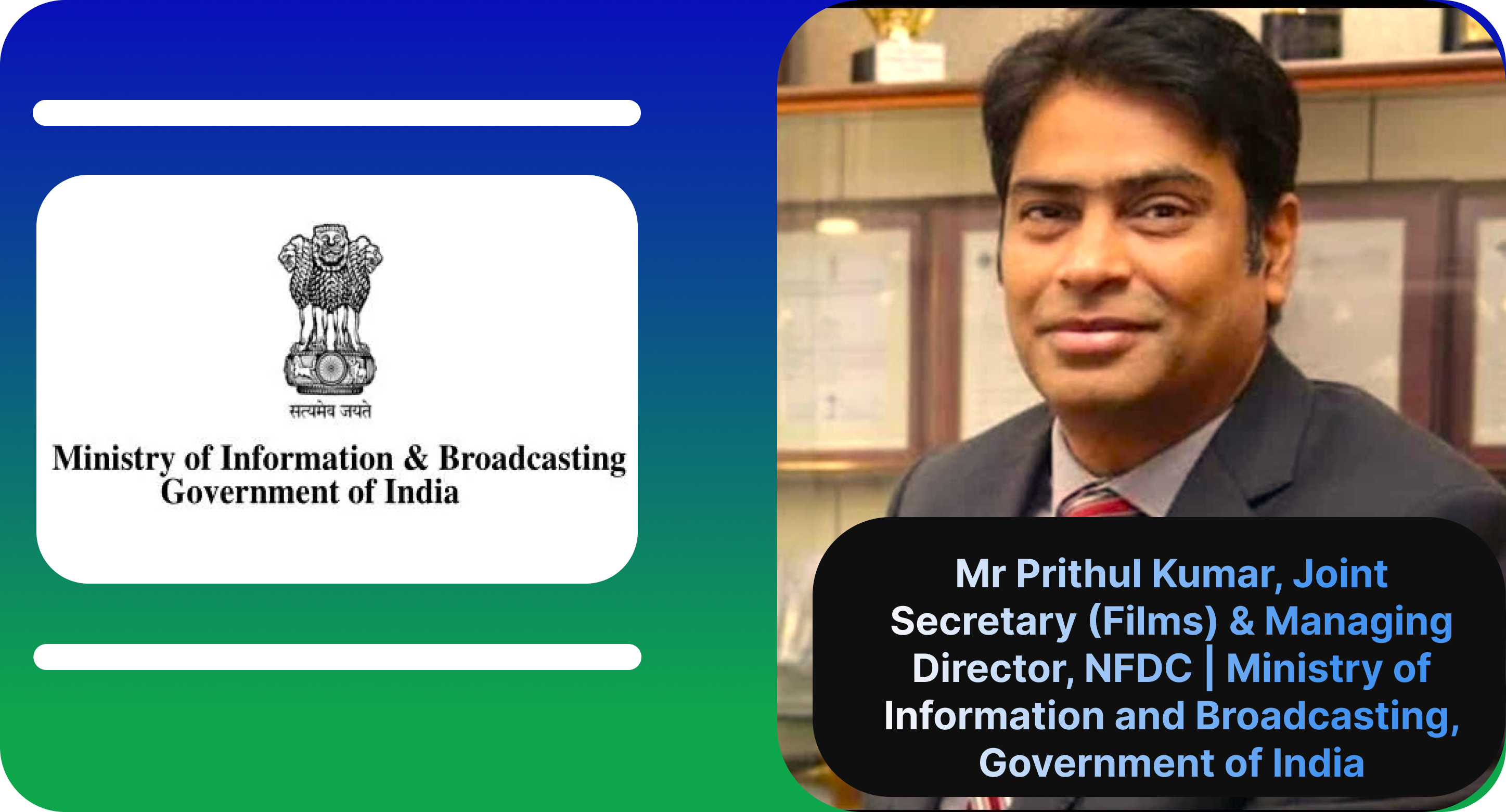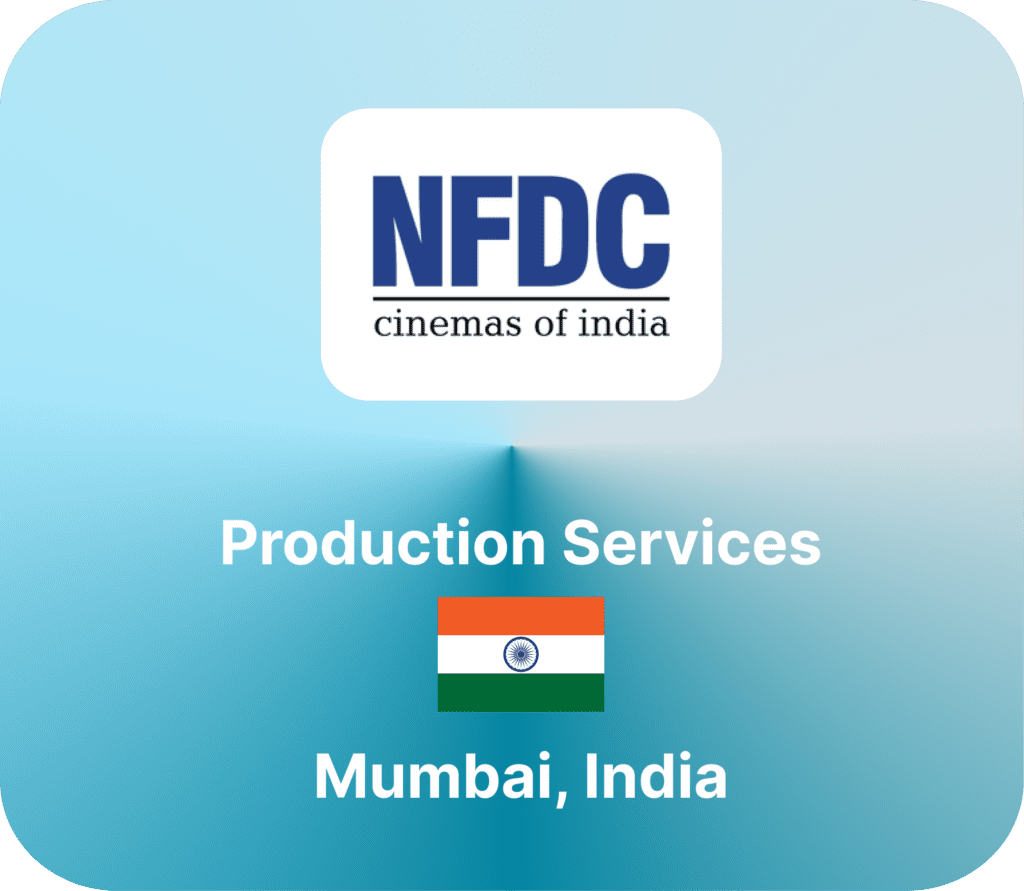Greetings Vitrina Community,
Welcome to an insightful conversation with Mr. Prithul Kumar, Joint Secretary (Films) & Managing Director, NFDC Ministry of Information and Broadcasting, Government of India. Join us as we delve into the dynamic world of Indian cinema, exploring the impact of production incentives and the exciting trajectory of the nation’s film industry.
Vitrina: Mr. Kumar, it's an honor to have you with us today. Let's dive straight into our discussion about the initiatives undertaken by the government of India for the promotion and development of the film industry. Can you share with us some of the key initiatives your office is currently driving?
Mr. Prithul Kumar: Thank you for having me, and good morning to all our listeners. Over the past year, the government has embarked on several remarkable initiatives to reform and enhance the film and audio-visual landscape in India. One significant milestone was the reform of the Cinematograph Act, which governs film exhibition in India after four decades. This was crucial given the advancements in technology and the emergence of new challenges such as online piracy. The amendments addressed these challenges effectively, including the need for more descriptive content classification. As a result, we’ve seen a decline in piracy and an increase in total film revenues.
Additionally, we’ve revamped initiatives launched in 2022, significantly increasing incentive caps to make them more competitive on a global scale. The revised cap, now at $3.6 million, is among the world’s best, offering substantial incentives for foreign productions to collaborate with India. Furthermore, the government has identified the animation, visual effects, gaming, and comics (AVGC) sector as one of the twelve champion service sectors. With the advent of the metaverse and 5G technology, the demand for content creation in this segment will be pivotal. We’re committed to fostering growth and innovation in this dynamic sector.
Vitrina: It's fascinating to hear about the AVGC sector and its significance, especially in light of emerging technologies like the metaverse. Could you elaborate on how the government views this sector within the larger framework of the economy, particularly in terms of production incentives and programs?
Mr. Prithul Kumar: Absolutely. We recognize the pivotal role of the AVGC sector in content creation, given the rapid evolution of technologies such as the metaverse and the increasing gamification trends. This sector encompasses animation, visual effects, augmented reality, gaming, and comics, and it’s distinct from the IT sector, drawing primarily from individuals with backgrounds in fine arts and Eurographics.
Last year, the government established a task force comprising industry experts and relevant government departments to address the sector’s needs comprehensively. This task force, with over 80 members, including more than 50% from the industry, worked on various aspects, from education to infrastructure development.
The focus extends from early education, ensuring children are aware of the career opportunities in this sector, to identifying skill gaps and implementing education and training programs at all levels. Infrastructure development, particularly in terms of IT resources, is also a priority, with collaboration between the central and state governments to provide incentives for industry growth.
Several states have already rolled out their policies to incentivize the AVGC sector, covering aspects such as space allocation and tax benefits. At the national level, we’re working on a comprehensive policy to promote the sector further, along with plans for a national center of excellence to guide education, skill development, and infrastructure enhancement across the country.
The government, in collaboration with industry stakeholders, is committed to nurturing the AVGC sector, recognizing its significance in shaping the future economy.
It's impressive to see the rapid expansion of states implementing policies to support the AVGC sector. Could you shed some light on the key emerging centers for talent in this sector and the impact of these policies on industry growth?
Mr. Prithul Kumar: Indeed, the growth of the AVGC sector has been remarkable, with a significant increase in the number of states actively promoting it. In just a year, we’ve seen 13 states formalize policies to support the sector, with 10 more actively engaging with industry stakeholders. These states are not just providing incentives but also investing in infrastructure to foster a conducive environment for startups and industry players.
While traditionally cities like Hyderabad, Bangalore, and Mumbai have been favored hubs, the landscape is rapidly evolving. Chennai, once renowned for post-production, continues to play a significant role. However, it’s essential to note that the importance of specific centers is shifting as more states recognize the sector’s potential.
The AVGC sector is becoming increasingly integral to content creation, with post-production, including VFX, now accounting for about 40% of total production expenses. India’s Film Facilitation Office (FFO), established in 2016, serves as a gateway for international productions seeking location shooting or post-production services in India. The recent revision of FFO guidelines aims to streamline processes, reducing processing time to below two months. Simplified documentation requirements and seamless incentive delivery are among the key enhancements.
The revamped FFO portal will further enhance the ease of doing business, providing a one-stop solution for filmmakers. It will facilitate online processing of incentives and clearances, eliminating the need to navigate through multiple agencies. Additionally, the portal will feature comprehensive mapping of filming resources, including locations and skilled professionals, enabling efficient planning and execution of projects.
While implementation will occur in phases over the next six months to a year, the long-term vision is to establish a robust ecosystem that supports and nurtures the AVGC sector’s growth across the country.

Vitrina: It sounds like a game-changer, simplifying processes and offering substantial support. So, with the central government primarily focusing on incentives for foreign film productions, how does the coordination with state governments work in terms of these incentives?
Mr. Prithul Kumar: Absolutely. The coordination between the central and state governments is crucial, especially concerning incentives for film productions. While the central government incentives primarily target foreign film productions, state governments have also rolled out their policies. These state-level incentives can complement the central offerings, potentially increasing the total incentives to up to $4 million, depending on the state’s limits and conditions.
Furthermore, foreign film production agencies can benefit from tax credits, including the general services tax, which is refunded for services rendered abroad. However, one of the most significant advantages is India’s cost competitiveness. Services here are typically two to three times cheaper than elsewhere, without compromising on quality. This cost advantage, combined with India’s vast pool of skilled professionals and resources across the entire spectrum of filmmaking, makes it an attractive destination for film productions of all scales and requirements.
Vitrina: That's fascinating to hear about the remarkable success of the Film Facilitation Office in expediting clearances for foreign productions and subsequently extending its support to the local film industry. With the local industry gaining access to these facilitations, are we witnessing an uptick in collaborations with foreign partners?
Mr. Prithul Kumar: Absolutely. The response from the local industry has been incredibly positive. Since 2019, the Film Facilitation Office has been instrumental in not only assisting foreign productions but also facilitating local film shoots across India. This extension of support has been met with enthusiasm from both state governments and local filmmakers, with various states offering additional incentives to promote filming within their territories.
Moreover, the global trend towards co-productions has gained significant traction. With India boasting co-production treaties with 16 countries, there has been a notable surge in collaborations between Indian and foreign producers. These partnerships are driven by the recognition of shared benefits, where films produced under such agreements enjoy national status in both countries, thus opening up audiences and opportunities on a global scale. This cross-cultural exchange enriches storytelling and enhances acceptance among diverse audiences, making co-productions an increasingly attractive avenue for filmmakers.
Vitrina: Absolutely fascinating! It's remarkable to witness the surge in content production across various international markets, especially in Europe and countries like Australia, France, and Canada. These regions are experiencing a significant boost in filmmaking activity, thanks to robust government support and proactive film commissions that are actively fostering growth within the industry.
Mr. Prithul Kumar: Indeed. The expansion of content production is truly impressive, and we’re continuously working to broaden our collaborative efforts. Australia, for instance, was added as the latest addition to our treaty countries just last year. Additionally, we already have established co-production treaties with France and Canada. Currently, negotiations with countries like Colombia and Uruguay are in the final stages, and talks with about 15 more countries are advancing rapidly.
In the coming years, we anticipate a substantial increase in the number of official co-production treaties. These treaties not only enhance government incentives, with both nations contributing to the production’s financial support, but also ensure access to a vast audience, including the significant Indian market. This mutual collaboration holds immense potential for the global film industry’s growth and development.
Vitrina: For our members who are exploring India as a potential filming destination, especially to capitalise on the tax incentives and schemes you've mentioned, could you shed some light on how they can access this information?
Mr. Prithul Kumar: Absolutely. The primary point of contact for accessing information about Indian film industry incentives is our website, where we have detailed documentation regarding the latest guidelines and incentives, particularly in relation to the Film Facilitation Office (FFO). Additionally, for any specific queries, individuals can directly reach out to FFO officials via the provided contact numbers and email addresses.
We’re also actively working on outreach initiatives to raise awareness about these incentives. Recently, we’ve engaged Indian missions abroad to serve as contact points for disseminating information about the incentives. We’ve conducted sessions with them, providing relevant documents to be shared with film commissions in their respective countries.
Furthermore, we’re promoting this information through film industry sessions at major international film festivals. For instance, we recently had an important session at the European Film Market in Berlin, and we’re scheduled to conduct a session at Cannes on the 15th of May at the main Marché du Cannes auditorium. These sessions aim to educate stakeholders about the available incentives and the ease of accessing them.
Vitrina: Expanding on our discussion about outreach initiatives, are there any conferences or launch events in India that invite international industry participation?
Mr. Prithul Kumar: Absolutely. One of our flagship events is the International Film Festival of India (IFFI), held annually in November. Alongside IFFI, we have the Film Bazaar, a film market that attracts delegates from around the globe. Last year, films from 104 countries were showcased at IFFI, with delegates from over 40 countries attending both the festival and the film bazaar. It serves as a significant platform for experiencing Indian cinema and exploring filming opportunities in India.
Furthermore, we have the Mumbai International Film Festival, scheduled to take place from June 15th to 21st in Mumbai. This biennial festival focuses on documentaries, animation, and shorts. Given the growing interest in documentaries worldwide, we’re aiming to enhance the festival experience this year. Additionally, we’re introducing a component of the Film Bazaar dedicated to documentaries and animation. We’re also inviting participation from various countries to share their film policies and explore potential collaborations. This event presents another valuable opportunity for industry professionals to engage with the Indian film industry.
Vitrina: As we wrap up, could you share some insights into the milestones and targets you're tracking for the next couple of years?
Mr. Prithul Kumar: Certainly. Our primary goal is to attract a diverse range of projects, both small and large-scale productions, to India. We want our initiatives to be appealing to filmmakers of varying budgets, ensuring that the incentives provided cater to a wide spectrum of projects.
With the recent increase in the cap to $3.6 million, we aim to attract larger projects, potentially exceeding $10 million in budget, to take advantage of these incentives. Simplifying our policies and minimizing red tape are key strategies in achieving this objective.
Ultimately, our success will be measured by the number and size of projects choosing India as their filming destination, as well as the overall growth and vibrancy of the Indian film industry.







